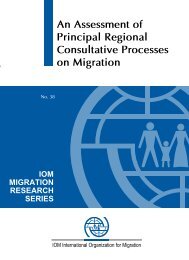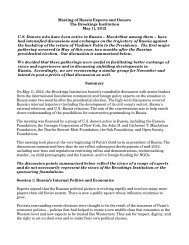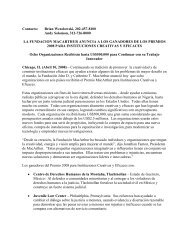A Global Compact on Learning - Brookings Institution
A Global Compact on Learning - Brookings Institution
A Global Compact on Learning - Brookings Institution
Create successful ePaper yourself
Turn your PDF publications into a flip-book with our unique Google optimized e-Paper software.
learning crisis (see figure 1.2). 46 In Uganda, more<br />
than <strong>on</strong>e-quarter of children in grade 7 could not<br />
read and understand a simple story at the grade 2<br />
level of difficulty. 47 In Mali, nine out of ten grade 2<br />
students studying in French could not read a single<br />
word of c<strong>on</strong>nected text. Three out of ten youth cannot<br />
do basic arithmetic in emerging ec<strong>on</strong>omies. 48<br />
According to the 2010 Annual Status of Educati<strong>on</strong><br />
Report, which surveyed 750,000 children across<br />
rural India, <strong>on</strong>ly 53 percent of students in grade 5<br />
could read a class 2 text. Nati<strong>on</strong>ally, this number has<br />
not g<strong>on</strong>e up in five years. In fact, the ability of children<br />
in India to do basic arithmetic has declined. 49<br />
Despite an increase in educati<strong>on</strong> expenditures in India,<br />
learning outcomes have remained the same or<br />
gotten worse. 50 And these problems extend to sec<strong>on</strong>dary<br />
schools in many countries,<br />
where many children—<br />
sometimes a majority—perform<br />
well below the accepted gradelevel<br />
standards. 51 For example, in<br />
Peru, <strong>on</strong>ly 20 percent of fifteenyear-olds<br />
were able to identify<br />
<strong>on</strong>e piece of informati<strong>on</strong> in a<br />
text. <strong>Learning</strong> outcomes for girls<br />
in c<strong>on</strong>flict-affected countries are<br />
some of the worst in the world. 52<br />
Universal primary educati<strong>on</strong> will<br />
not be achieved without paying<br />
attenti<strong>on</strong> to learning. Much discussi<strong>on</strong><br />
in policy discourse has<br />
been about expanding access or<br />
improving quality. Undoubtedly,<br />
providing high-quality educati<strong>on</strong><br />
to more learners will cost<br />
more than when it was reserved<br />
for just the elite. However, there<br />
is no real choice between access<br />
and quality as a country will<br />
not achieve universal primary<br />
completi<strong>on</strong> without also paying<br />
Mali<br />
Niger<br />
attenti<strong>on</strong> to learning outcomes. Cross-country data<br />
show a positive correlati<strong>on</strong> between educati<strong>on</strong> coverage<br />
and average learning levels (see figure 1.3). 53<br />
In fact, countries that have d<strong>on</strong>e well in <strong>on</strong>e respect<br />
have also generally tended to do well in the other,<br />
Burki<br />
and vice versa; 54 acti<strong>on</strong>s that improve learning outcomes<br />
help meet attainment goals. C<strong>on</strong>versely, there<br />
is a direct relati<strong>on</strong>ship between low learning levels<br />
(as measured by test scores) and dropout rates. 55 Impressive<br />
gains in access will <strong>on</strong>ly be sustained by improving<br />
both the developmental status of children<br />
before they enter formal schooling and the teaching<br />
and learning processes employed during the lower<br />
primary years. 56 Although the overall envelope for<br />
educati<strong>on</strong> spending needs to be bigger, this report<br />
seeks to outline where those increased investments<br />
should be targeted to better link comp<strong>on</strong>ents of the<br />
system across a child’s life span, improve efficiency<br />
and effectiveness throughout the educati<strong>on</strong> system,<br />
and increase the return <strong>on</strong> investment through<br />
higher social, ec<strong>on</strong>omic, and political benefits.<br />
Figure 1.3. Correlati<strong>on</strong> between <strong>Learning</strong> Levels and<br />
Enrollment, 1990–2003 (average of primary and sec<strong>on</strong>dary<br />
school net enrollment ratios)<br />
TIMSS 1999 equivalent scale<br />
600<br />
550<br />
500<br />
450<br />
400<br />
350<br />
300<br />
250<br />
200<br />
150<br />
Tanza<br />
Mozam<br />
Madag<br />
Cote Ugand<br />
Zambi<br />
Lesot<br />
KoreaJapan<br />
H<strong>on</strong>g<br />
Hunga Nethe Belgi<br />
Macao SwCzech<br />
Liech<br />
itz Austr Canad Slove<br />
Irela<br />
Unite Unite Franc Sw Finla ede<br />
Germa Bulga<br />
Malay Latvi<br />
Cuba Polan<br />
Icela New Spain<br />
Luxem Denma Norw Z<br />
Greec a<br />
Serbi Roman<br />
Portu Lithu Italy<br />
Armen<br />
Tunis<br />
Trini Moldo CypruIsrae<br />
Seych<br />
Mexic Maced<br />
Jorda<br />
Brazi Turke Iran-<br />
Kenya<br />
Ind<strong>on</strong> Mauri<br />
Alban Argen<br />
Leban Egypt Pales<br />
Parag Colom Kuw Chile<br />
Bahra<br />
ai Boliv<br />
H<strong>on</strong>duDomin<br />
Peru<br />
Venez<br />
Saudi<br />
SwZimba<br />
azi<br />
Botsw Phili<br />
Moroc<br />
Beliz<br />
Ghana<br />
Malaw<br />
Namib<br />
SouthAfr<br />
10 20 30 40 50 60 70 80 90 100<br />
Source: L. Crouch and P. Vinjevold, “South Africa: Access before Quality, and What to Do Now?”<br />
Profesorado: Revista de currículum y formación del profesorado 10, no. 1 (2006).<br />
Interventi<strong>on</strong>s targeting gender differences have focused<br />
<strong>on</strong> access, not learning outcomes. Addressing<br />
gender gaps in educati<strong>on</strong> has mainly been defined<br />
in terms of access rather than looking at gender inequalities<br />
in educati<strong>on</strong>al quality. 57 However, gender<br />
A <str<strong>on</strong>g>Global</str<strong>on</strong>g> Compa c t <strong>on</strong> <strong>Learning</strong>: Taking Acti<strong>on</strong> <strong>on</strong> Educat i o n in Developing Countries<br />
C e n t e r for Universal Educat i o n at <strong>Brookings</strong><br />
11






